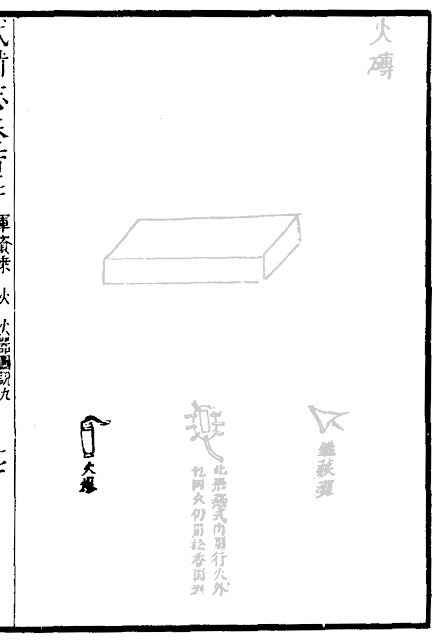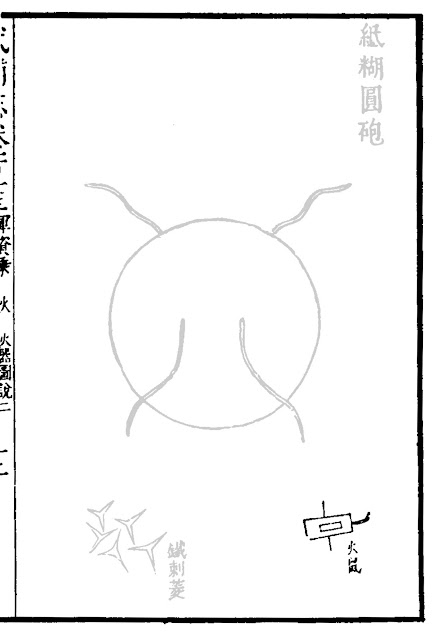 |
| Section of the scroll painting 'Ru Bi Tu (《入蹕圖》)', depicting Emperor Shenzong's entourage launching bottle rockets into the sky. |
Fireworks originated in China during the last years of Northern Song Dynasty, centuries after the first weaponised use of gunpowder in China. While originally a civilian application of military technology, the bright flashes and loud salutes of these pyrotechnics had uses outside of celebration and recreation, so fireworks were re-militarised once again.
The primary military application of fireworks was communication. However, military fireworks also served more sinister purposes such as disorienting enemy troops or horses and starting fire.
Qi Huo (起火, lit. 'Rising fire')
Qi Huo is essentially a
Chinese rocket without its arrowhead and warhead. It is usually employed for signalling purpose, but can be used in place of live ammunition during military exercise as well.
Nowadays Qi Huo is better known as
skyrocket or
bottle rocket.
Huo Bao (火爆, lit. 'Firecracker')
 |
| Drawing of a Huo Bao (highlighted), from 'Wu Bei Zhi (《武備志》)'. |
Also known as
Zhi Bao (紙爆, lit. 'Paper cracker') or
Zhi Huo Bao (紙火爆, lit. 'Paper firecracker'), this small explosive device produces a loud bang when ignited. Huo Bao can be used on its own as signalling device, or several Huo Bao can be loaded into other bombs to produce enemy-disorienting bangs. Some Huo Bao are even filled with deadlier versions of gunpowder, which turn them into dangerous bomblets.
Ming arquebusiers also
used firecrackers to produce fake gunshots in order to confuse their enemy.
Huo Shu (火鼠, lit. 'Fire mouse')
 |
| Drawing of a Huo Shu (highlighted), from 'Wu Bei Zhi (《武備志》)'. |
Also known as
Huo Lao Shu (火老鼠),
Fei Shu (飛鼠, lit. 'Flying mouse'),
Di Shu (地鼠, lit. 'Ground mouse'),
Di Lao Shu (地老鼠), and
Fei Tu (飛兔, lit. 'Flying hare'), this firework
moves in unpredictable patterns once ignited. Military version of Huo Shu, designed to start fire and cause confusion, is much more powerful and dangerous than the recreational version.
Some Huo Shu are also equipped with iron barbs that allow them to catch onto any surface they touch.
Fei Yan (飛燕, lit. 'Flying swallow')
 |
| Drawing of a Fei Yan (highlighted), from 'Wu Bei Zhi (《武備志》)'. |
Also known as
Fei Yan Zi (飛燕子), this is a dangerous incendiary micro-rocket that flies in a unpredictable trajectory due to its lack of fins or stabilising stick. Similar to Huo Shu, it is also designed to start fire and cause confusion.
The outer shell of Fei Yan is made of flammable and sticky rosin that allows it to stick to whatever surface it touches.




This comment has been removed by the author.
ReplyDeleteSorry, I don't really get your question...
DeleteAre every weapon on this blog just from a video game OR have these weapons existed in real world because your blog says resources for historical wargaming field of glory and so on
ReplyDeleteReal world, of course. I don't recall seeing any video game that can get so creative.
DeleteThanks man, You're right :D
DeleteOf course these weapons existed in the past since they had been documented on Ming period military treatises. I don't understand why you even asked such a question.
DeleteAFAIK, no video game has ever reflected the ancient Chinese (or even modern Chinese) military in its full glory.
DeleteWell, there is a China factin in C&C: General...
Delete